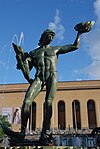Museum of Gothenburg

The Museum of Gothenburg (Swedish: Göteborgs stadsmuseum) is in the city centre of Gothenburg, in western Sweden. It is located in the 18th-century East India House (Swedish: Ostindiska huset), originally built as the Swedish East India Company offices. The city museum was established in 1861.
The City Museum is a cultural history museum. It displays Gothenburg and West Sweden's history, from the Viking Age to the present day. There is a permanent exhibition about the Swedish East India Company. However, the maritime history of Gothenburg has a separate museum of its own.
The museum is also used as a public forum for the Gothenburg Town Planners to display new ideas and visions of the city for the citizens.
History[]
The museum was founded as the 'Göteborgs stadsmuseum' in East India House in 1861. Modelled on the Victoria and Albert Museum in London, it initially comprised natural history, art and books and covered art, science and industry. Its founders were Sven Adolf Hedlund, AF Ericsson, August Malm and Victor von Gegerfelt. The merchant John West Wilson paid for a fourth wing, opened in May 1891 shortly after his death.
At the time of the Gothenburg Exhibition in 1923 the city's collections were split in two, with the art housed in the Göteborgs konstmuseum and the rest in the Göteborgs museum or Göteborgs naturhistoriska museum. Between 1993 and 1996 several of the city's museums on archaeology, general history and the history of industry, education and theatre merged to form the Göteborg City Museum.
External links[]
| Wikimedia Commons has media related to City Museum of Gothenburg. |
Coordinates: 57°42′23″N 11°57′48″E / 57.70639°N 11.96333°E
- Museums in Gothenburg
- City museums in Sweden
- History museums in Sweden
- Swedish East India Company
- Listed buildings in Gothenburg
- Government buildings in Sweden
- 1861 establishments in Sweden
- Swedish museum stubs

